Nutrient Management
 IMPORTANCE OF NUTRIENTS
IMPORTANCE OF NUTRIENTS
 MANURING
MANURING
 INTEGRATED NUTRIENT MANAGEMENT
INTEGRATED NUTRIENT MANAGEMENT
 METHODS OF FERTILIZER APPLICATION
METHODS OF FERTILIZER APPLICATION
 PHYSIOLOGICAL DISORDER
PHYSIOLOGICAL DISORDER
Importance of Nutrients
-
Crop growth depends on, among other things, nutrients. Both macro and micronutrients are essential for plant growth.
-
Macronutrients are those elements needed in large amounts by the crop, and large quantities have to be applied if the soil is deficient in one or more of them.
-
Nitrogen (N), Phosphorus (P) and Potassium (K) are the ‘primary macronutrients’ and these form the basis of NPK fertilizer compounds. The ‘secondary macronutrients’ are Calcium (Ca), Magnesium (Mg) and Sulphur (S).
-
Micronutrients are those elements required in very small quantities. Despite being needed in small quantities, micronutrients are essential for the overall performance and health of the Ragi crop. They include Iron (Fe), Manganese (Mn), Zinc (Zn), Copper (Cu), Molybdenum (Mo), and Boron (B).
Macro Nutrient |
Micro Nutrient
|
Macro Nutrient
Nitrogen
Effects of Nutrients
-
Nitrogen is the chief promoter of growth. It induces vegetative growth of pseudostem and leaves giving a healthy green colour and robust frame which are essential for high yields.
-
N influences the number of leaves produced, time taken for the leaf unfolding and longitudinal growth of petioles.
-
During the first 4-6 months of planting if there are more healthy and large sized leaves, the bunch size will also be larger. Hence, N influences bunch grade and sucker production.
Symptom of Damage
-
The leaves become pale green in colour.
-
Midrib, petiole and leaf sheath show reddish-pink colouration.
-
Besides delay in leaf emergence, shortening of internodes occurs.
-
In excess of nitrogen, the plants are vigorous but the bunches are small and the fingers do not fill out properly thereby fruit quality gets affected.
-
Nitrogen deficiency causes growth reduction, chlorotic leaves with reduced area and rate of leaf production.
-
Leaf petioles are short, thin and compressed, thin profuse roots and lesser number of suckers is produced due to low .Nitrogen and Phosphrous uptake increases.
Control Measures
-
Small pit should be taken and 100g urea per plant should be applied followed by irrigation.
Phosphorus
Effects of Nutrients
-
Phosphorus helps produce healthy rhizome and a strong root system.
-
It also influences flower setting and general vegetative growth.
Symptom of Damage
-
Phosphorous is required in the plant crop cycle between 3 to 9 months after planting.
-
Phosphorous is relatively lost during flowering and fruiting and redistributed to the follower or sucker.
-
The symptoms to appear are stunted growth with poor root development, chlorosis and breaking of leaf petioles.
-
Low Magnesium supply reduces root uptake and distribution of Phosphorous.
-
Initial greening of leaves followed by marginal chlorosis has been designated to be phosphorus deficiency.
-
Initial greening of leaves followed by marginal chlorosis has been designated to be phosphorus deficiency.
-
Phosphorous deficiency causes complete cessation elongation.
-
At a height of about 2 ft. rossetting of leaves with older leaves becoming increasingly and irregularly necrotic leaf production is reduced, and marginal chlorosis and premature death are caused.
Control Measures
-
50g Diammonium phosphate or 300g super phosphate added to each pit followed by irrigation.
Potassium
Effects of Nutrients
-
Potassium stimulates early shooting and significantly shortens the time required for fruit maturity.
-
It improves bunch grade and size of fingers and also the quality of the fruits.
Symptom of Damage
-
The leaves become smaller and are slower to grow,followed by rapid yellowing starting from the tip of older leaves. The yellow leaf dries up quickly and the leaf tip curls inward.Later the dead leaf breaks near the bottom of the lamina.Fruits are badly shaped, poorly filled and unsuitable for marketing
-
Potassium deficiency causes marked reduction in growth,production of new leaves and leaf area and premature yellowing of leaves. Once the stored potassium is exhausted, deficiency symptoms appear suddenly starting with yellowing of tips and distal margins of older leaves closely followed by necrosis and desiccation.
-
The yellowing and necrosis spread rapidly in a proximal direction until the whole leaf has withered in a normal position.
-
Lamina splitting occurs and folds downwards. While the midrib bends and fractures leaving the distal half of the petiole leaf hanging.
-
Purplish brown blotches appear at the base of the petioles and in severe cases the centre of the corm may show areas of brown, water soaked disintegrated cells.
Control Measures
-
Foliar spray of potassium sulphate 1% (10g per liter of water) on leaves or 225g muriate of potash + 125g urea should be added along with well decomposed FYM to each pit followed by irrigation.
Magnesium
Effects of Nutrients
-
Deficiencies usually occur while bananas have been grown for 10-12 years without magnesium fertilizer or where high amounts of potassium fertilizer have been given for a number of years.
-
Magnesium is considered to be moderately redistributed in the banana plant.
-
A large range of leaf symptoms have been attributed to magnesium deficiency, including marginal yellowing extending to near the midrib, changes in phyllotaxy, purple mottling of the petioles, marginal necrosis and separation of leaf sheaths from Pseudostem.
Symptom of Damage
-
Leaf symptoms include marginal yellowing and spread along the midrib showing V shape green pattern. Separation of leaf sheaths from the pseudo stem.
-
Blue disease; purple blotching of petioles and necrotic patches on the older leaves.
Control Measures
-
Application of magnesium sulphate 25g per plant should be added followed by irrigation.
Calcium
Effects of Nutrients
-
Although calcium is quite immobile in the banana, early description of calcium deficiency referred to a marginal scorch on older leaves.
-
It appears that these symptoms may have been an artifact of high sodium supply. In the field calcium deficiency symptoms include spike leaves i.e. leaves in which the banana is deformed or almost absent.
-
In Calcium deficient plants, fruit quality is inferior and the skin splits when ripe.
Symptom of Damage
-
Youngest leaf become abnormal in size , leaf margins become dry and veins become erupted and cause the spike leaf in which the lamina on new leaves is deformed.
-
It causes heart rot to newly planted tissue culture plantlets.
-
The fruit quality is inferior and the peel splits during ripening.
Control Measures
-
Dehydrated lime 50g per plant should be added followed by irrigation.
Sulphur
Effects of Nutrients
-
Sulphur is actively redistributed from old to young leaves, symptoms appear in the young levels, which are yellowish white.
-
As the deficiency progress, necrotic patches appear on leaf margins and slight thickening of the veins occurs, similar to B and Ca deficiencies.
-
The growth is stunted and the bunch is very small or chocked.
-
The most rapid uptake of sulphur occurs between the sucker and shooting stages. After shooting, the uptake rate is reduced and sulphur needed for fruit growth comes from the leaves and Pseudostem.
-
Sulphur imbalance causes an increase in nitrogen concentration in leaves.
Symptom of Damage
-
The sulphur deficiency symptoms appear in both young and old leaves. The initial symptoms are chlorosis in young leaves and reduced leaves development.The leaves took on a silver-green colouring.
Control Measures
-
Apply 100g Ammonium sulphate per plant or Apply 100g gypsum per plant.
Micro Nutrient
Boron
Effects of Nutrients
-
Deficiency of boron may results in reduction in weight and size of the bunch and it will effects the proper filling of the bunch.
-
For boron deficiency apply 20 g borax per litre at the time of planting of spray boric acid at 0.2 % in 4th of 5th month after planting.
Symptom of Damage
-
The symptoms include leaf curling and deformation and apparently unequal size and width of the lamina. Boron deficiency produces small deformed leaves. Veins will be prominent with streaks across the veins on the leaf.Difficulty in rooting of suckers.
-
Marked deformity of young leaves which are reduced in size.Sometimes consisting only of the midrib.
-
Leaf shape irregular with curled and undulating margin.
-
Interveinal chlorosis and striation at right angles to main veins,necrosis without previous chlorosis on leaf margins especially the tips, leaf tip breakage and tearing and shoot proliferation.
-
Severe deficiency causes all growth to stop.
-
Boron deficiency occurs more in humid areas.
Control Measures
-
Application of sodium tetraborate @ 25g per plant should be applied followed by irrigation.
Iron
Effects of Nutrients
-
Iron deficiency has been recorded in alkaline soils and is identified by interveinal chlorosis of young leaves.
-
Application of iron sulphate will correct the iron deficiency.
Symptom of Damage
-
Younger leaves become pale green or white in colour.
Control Measures
-
Foliar spray of 0.5% (5g per litre of water) ferrous sulphate along with wetting agent.
Zinc
Effects of Nutrients
-
Zinc deficiency is found in banana when it grows in zinc deficient soils. Narrow pointed and chlorite young leaves, Bunch top crowns are the symptoms of zinc deficiency .
-
Application of 50 g/plant zinc sulphate at the time of planting is recommended or foliar application of zinc sulphate at 3 g/litre + urea (5g per litre) + 10 ml non ionic sticker in 20 litres of water. The above prepared solution is sprayed at 45 and 60 days after planting.
-
For ratoon crop 45 days after cutting the mother plant.
Symptom of Damage
-
The symptom causes the leaves to become narrow, with yellow to white stripes between the secondary veins. This results in alternating yellow and green stripes.
-
Zinc deficiency in saline soil with no or little organic content.
-
Zinc deficiency is characterized by small and narrow tapered leaves with interveinal chlorosis. New leaves are small.Flowering is delayed. Bunches become small with bottle -necked fruits. Chlorosis in strips, the chlorotic bands parallel to main veins often almost white and of variable width alternating with green bands.
-
Severe deficiency causes young leaves to be small, elongated and pointed,entirely chlorotic with white dots visible against the light.
-
In severely affected plants fruit development is slow; the bunch is yellow and almost horizontal for a relatively longer period.
-
Fingers appear twisted are shorter, smaller, thinner and lighter green in colour.
-
Distal ends of fruits are nipple shaped.
Control Measures:
-
Zinc sulphate @ 15 - 30g per plant should be added followed by irrigation.
Manuring
Organic Manuring
Farmyard manure
 |
-
Farm yard Manure is prepared basically using cow dung cow urine, waste straw and other dairy wastes.
-
FYM is rich in nutrients.
-
A larger portion of nitrogen is made available as and when the FYM decomposes. balanced nutrition is made available to the plants.
-
Availability of Potassium and Phosphorus from FYM is similar to that from inorganic sources. Application of FYM improves soil fertility.
Bio fertilizers
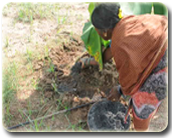 |
-
Biofertilizers are ready to use live formulates of such beneficial microorganisms which on application to seed,root or soil mobilize the availability of nutrients by their biological activity in particular, and help build up the micro-flora and improves soil health.
-
It increases the crop yield by 20-30%.
-
Replace chemical nitrogen and phosphorus by 25%.
-
Stimulate plant growth.
-
Activate the soil biologically.
-
Restore natural soil fertility.
-
Provide protection against drought and some soil borne diseases.
Green manuring
 |
-
Green manuring is the practice of growing a short duration, succulent and leafy legume crop and ploughing the plants in the same field before they form seeds.
-
Green leaf manuring refers to adding the loppings from legume plants or trees to a field and then incorporating them into the soil by ploughing
-
Green manuring improves the nitrogen use efficiency or nitrogen fertilizer as well as conservation and utilization of soil moisture.
Compost
 |
-
Compost is well decomposed organic wastes like plant residues, animal dung, and urine earth from cattle shed waste fodder etc.
-
Compost is dark in colour, sweet smelling and nutrient rich material
-
It increases organic matter in soils.
-
It increases water holding capacity of soils.
Vermicomposting
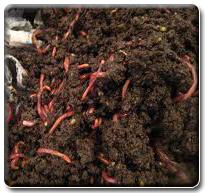 |
-
Vermicomposting is a type of compost making in which earthworms are used to convert organic wastes into valuable material to supply nutrients for crops.
-
This compost is an odorless, clean, organic material containing adequate quantities of N, P, K and several micronutrients essential for plant growth.
-
Vermicompost is a preferred nutrient source for organic farming.
-
It is eco-friendly, non-toxic, consumes low energy input for composting and is a recycled biological product.
Coir pith
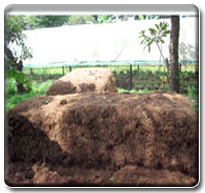 |
-
Coir pith is also known as Coco peat or Coir dust. This by-product of the coir industry can be converted into organic manure.
-
It contains all macro and micro nutrients like N,P,K,Ca,Cu,Mg.
-
It increases water holding capacity.
-
It improves aeration.
-
Enhances deep root system.
-
Eco-friendly.
Inorganic Manuring
Banana responds well to both manure and fertilizers. The dosages of nutrient to be applied depend on the variety, initial soil fertility, climate etc. It is very essential to induce quick growth and produce more leaves with larger area. The optimum quantity of nutrient, time and availability of nutrients to the plants are vital for optimum growth and production. To ensure adequate supply of nutrients during its critical growth and application of fertilizers should be completed within 100 to 120 days of planting. Inorganic Manures usually provide only one of the many substances needed by plants for their growth. Inorganic manures fill a specific nutritional need of the plant, much like a vitamin pill. If the plant is lacking a specific substance, inorganic manures can quickly fill that plant's need.
TamilNadu
Banana requires higher fertilization due to its rapid and vigorous growth and high fruit yield. The nutrient uptake studies also reveal that the uptake per unit area is more than any other crop. The nutrient uptake pattern analysis conducted in different countries showed that a crop of 40-60 t of yield/ha removes nearly 250-300 Kg N,25-40 Kg P,800-1200 Kg K,150-180 Kg Ca,40-60 Kg Mg and 14-20 Kg S per hectare. This reveals that the fertilizer applied should contain more of nitrogen and potash in the ratio of 1:3.
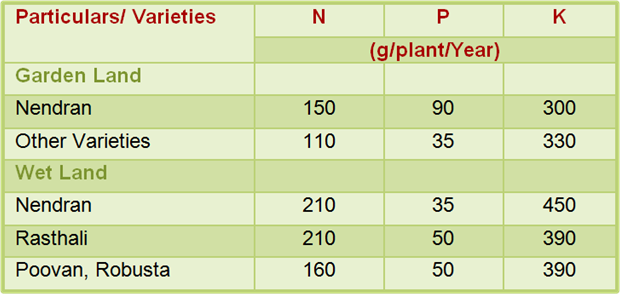 |
Kerala
Apply the fertilizer 60-75 cm around the plant in two equal split doses; the first, two months after planting and the second, four months after planting. For ratoon crop, the entire fertilizers have to be applied in a single dose immediately after the harvest of the preceding crop. Irrigate immediately after manuring.
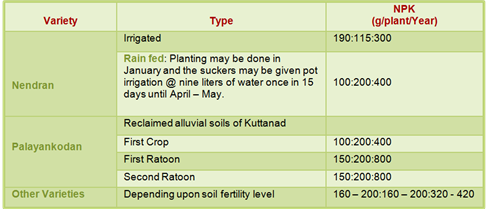 |
Note
 |
Karnataka
 |
Integrated Nutrient Management
-
Integrated nutrient management (INM) is the system of rationalization of the plant nutrition management to upgrade the efficiency of plant nutrient supply through adequate association of local and external nutrient sources accessible and affordable to the farmers.
-
Combined application of organic manures and chemical fertilizers generally produces higher crop yields than their sole application.
-
This increase in crop productivity may be due to the combined effect of nutrient supply, synergism and improvement in soil physical and biological properties.
-
Locally available various organic sources like coir pith, pressmud, FYM and copper ore tailings (COT) can be judiciously used to enhance the yield and profitability of crops.
-
Application of AM 250 g + phosphate solubilizing bacteria (PSB) 50 g + Azospyrillam 50 g/ plant along with 100% recommended dose of fertilizers (110:35:330 NPK/ plant is recommended to get high yield potential of 65 t/ha.
-
Foliar application of ZnSO4 0.2% + FeSO4 0.2% + CuSO4 0.2% + Boric acid 0.1% at 3rd , 5th and 7th month after planting along with recommended dose of fertilizers is recommended to improve the yield and quality traits.
-
Covering bunches with 150 gauge white polythene bunch cover with 2% vent holes immediately after opening of the last hand is recommended to enhance the bunch maturity by 20 days, reduce the blemished fruits by 19.26% and attractive coloured fruits.
-
Soil application of pseudomonas fluorescens 10 g/plant at the time of planting is recommended of nematodes.
-
Foliar spray of propiconazole 0.1% + pseudomonas flourescens 0.5%, three times at 15 days interval is recommended to effectively control sigatoka leaf spot disease.
-
Pseudostem injection of monocrotophos or dimethoate @ 1 ml + 5 ml water mixture administered @ 4 ml/ plant has to be adopted for the management of pseudostem borer in banana and to obtain benefit cost ratio of 2.85 and 2.79 for monocrotophos and dimethoate respectively.
-
Spraying mancozeb 0.25 % starting from 3rd month onwards with one month interval is recommended to reduce the leaf spot incidence.
Methods of Fertilizer Application
Split Application
-
Generally, Banana needs 150-200g N, 40-60g P2O5 and 200-300g K2O/plant/crop depending upon soil and cultivar.
 |
-
Application of one-fourth N and one-third K2O at reproductive phase is also found beneficial.
-
Application of N in reproductive phase delays the senescence of leaves and improves bunch weight.
-
Finger filling is better when one-third of k2O is applied at shooting stage.
Fertigation
Fertigation is a method of applying fertilizers,soil amendments and other water soluble products required by the plant during its growth stages through drip/sprinkler irrigation.The application of nutrients through irrigation systems is called fertigation, a contraction of fertilization and irrigation.The most common nutrient applied by fertigation is nitrogen.Elements applied less often include phosphorus, potassium, sulfur, zinc and iron.This technique can reduce fertilizer application costs by eliminating high operational requirement.It may also improve nutrient efficiency by applying them closer to when the plant needs them. Also, it could conceivably reduce leaching or denitrification (gaseous) losses of nitrogen and lower the luxury uptake of nutrients by plants.
Fertigation is a time-tested process of spoon feeding: Delivering small amounts of fertilizer through an irrigation system each time the system is operated. Classically, fertigation supplies nutrients in the form of fertilizers, although it can also be used to deliver soil amendments and a variety of other materials, including agricultural chemicals to cope with crop pests and plant diseases.
Foliar Application
-
Foliar application of nutrients provides quick and effective augmentation of nutrients and may prevent hidden hunger when properly timed.
-
Secondary and micro-nutrients are more amenable to foliar feeding owing to smaller crop requirement, but sprays of N,P and K have also been known to boost fruit bearing stage.
-
However, it is advisable to avoid blanket foliar application of multiple nutrients in favour of properly diagnosed single micro-nutrient spray for cost-effectiveness and ecological safety.
-
At reproductive stage, high nutrient availability is important to support plant requirements until harvest since large quantities of photosynthesis are beginning to move from the source to the sink-developing fruit bunches.
-
Any limitation in the supply of nutrients at this time will negatively affect bunch size and quality. However, it has not been wise to apply fertilizers basally at finger development stage, since the uptake is slow and low.
Arka Banana Special
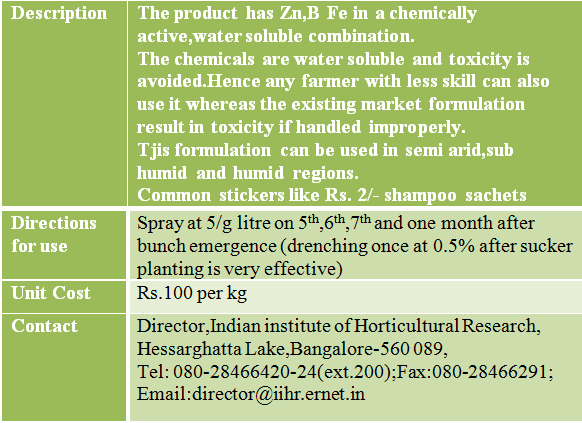 |
Foliar micronutrient formulation for Banana (Crop specific micronutrient formulations)
Application / Use:
For fast correction of micronutrient disorders in Banana soil application of micronutrient is inefficient (5%), delayed (30 - 45 days) and cost is high (Appx: Rs. 800 kg for Boron and Rs. 1500 for Zinc alone/ha. By this formulation 3 sprays. Cost is Rs.800/ha, correction within 24 – 48 hrs and nutrient use efficiency is 30 – 40%. Benefit cost ratio 9 : 1.
Input Needed:
Pulvenizer - 50 kg/hr Mixer 100 kg/batch Space: 90 sq meter (with drying yard) Raw material: Zinc sulphate, Boric acid, Borax, Ferrous Sulphate, Ferric citrate Fillers: Magnesium sulphate or Calcium sulphate Power needed: 5 HP Analysis of Raw material to be done in Atomic Absorption Spectro photometer (Zn, Fe), Visible spectro photometer (B) If Paid service is available enough. No need to have own instruments. Patenting Applied on 3rd March 2008.
Output Capacity:
100 kg/ 8 hrs. (if processed raw material is ready – 6 man days)
Specific Benefits:
Correction of micro nutrients very fast (24 – 48 hrs) and hence other inputs like NPK, water not wasted. Soil application inefficient. Spray on bunches Zn, Fe content of fruit increased, deficient in Indian diet – value addition at farm.
Unit Cost:
Rs. 100 per kg
Description:
The product has Zn, B & Fe in a chemically active, water soluble combination. The nutrients that are incorporated and the ratio have been identified by intensive research in identifying predominant nutrient disorders in all cultivars of Banana growing regions of Southern India considering the common limiting micronutrients by visual diagnosis, confirmed by soil and leaf analysis. The chemicals are water soluble and toxicity is avoided. Hence any farmer with less skill can also use it whereas the existing market formulation result in toxicity if handled improperly. This formulation can be used in semi arid, sub humid and humid regions. The cost is Rs. 100/kg, and common stickers like Rs. 2/- shampoo sachets in the village shops can be used. Common lemon/lime fruit juice increases the efficiency of uptake. Effective for garden land banana exp. with poor root health for all varieties including Neypoovan, D. Cavendish, Robusta, Grand nain (both tissue culture and suckers). Sprayed at 5/g litre, 5th, 6th, 7th and one month after bunch emergence (drenching once at 0.5% after sucker planting is very effective). Can be mixed with plant protection chemicals. Basic principle: India has approximately 2.2 lakh banana holdings and leaf analysis based nutrient correction involves 2 lakh samples per year analysis which is impossible. A composite formulation for correcting predominant disorders has proved effective. Technology being used and from 2002. Product worth sold Rs.14.00 lakh from ATIC of IIHR. In great demand promoted by KVK’s of Zone VIII. Efficient in correcting both visible deficiencies and hidden hunger of Zn, B & Fe.
Developed By:
Dr. M. Edward Raja, Principal Scientist & Head, Division of Soil Science & Agricultural Chemistry, IIHR, Bangalore
Contact Person:
Director, Indian Institute of Horticultural Research, Hessarghatta Lake, Bangalore-560 089, Tel: 080-28466420-24 (ext. 200); Fax: 080-28466291; email: director@iihr.ernet.in
Institute:
IIHR, Bangalore
Physiological Disorder
Kottai Vazhai
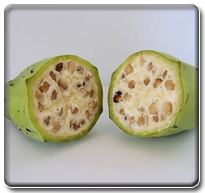 |
 |
 |
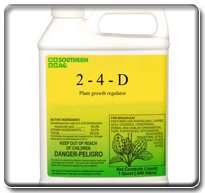 |
Symptoms
-
Poovan the leading commercial variety of India shows a predisposition to seediness locally known as 'Kottai vazhai'.
-
This malady is characterized by the presence of distinctly, conical and ill filled fruits with a prominent central core having many under developed seedy structures rendering the fruits inedible.
-
It is noticed only in Tamil Nadu
-
Incidence of 'Kottai vazhai' in the early stage are not detectable
-
Later, the 'Kottai vazhai' developed streaks, striations and blotches on the pseudo stem and on the leaves.
-
The second crop of 'Kottai vazhai' also has these blotches suggesting the possible presence of a genetic basis for the disorder.
-
The bunches are held at a angle above the horizontal position and the peduncle shows irregular curvatures.
Management
-
It is easily overcome by spraying of 2,4-D 20 ppm (1g in 50 litres of water) immediately after the last hand opens.
-
By this treatment seediness is completely overcome and the treated bunches are found to be better in quality
Finger drop
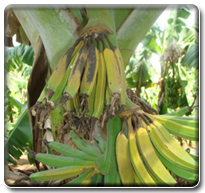 |
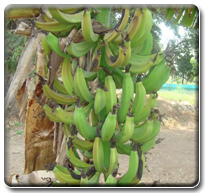 |
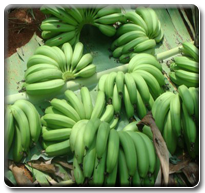 |
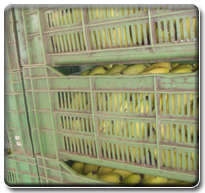 |
|
|
|
|
Symptoms
-
Finger drop is a physiological disorder which occurs as a result of softening and weakening of the pedicel which causes individual fruit of a hand to separate or dislodge very easily from the crown during ripening.
Management
-
Harvest physiologically matured green bunches
-
Dehand bunches and cut into clusters
-
Pack clusters in a carton
-
Ripen fruits by exposure to ethylene (1ml/litre) for 24-48 hours at a temperature of 14-18°c and relative humidity of 90-95%
-
Ventilate and allow the fruits at a temperature of 18°c
Peel splitting
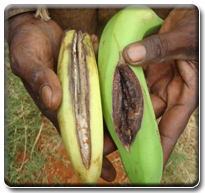 |
 |
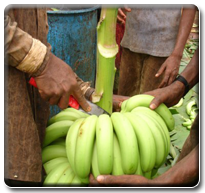 |
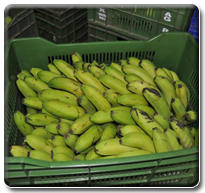 |
|
|
|
|
Symptoms
-
Longitudinal split of the peel, usually beginning from the proximal end near the pedicel.
-
The split usually divides the peel into unequal halves and ultimately expose the pulp as the split widens
Management
-
Harvest physiologically matured green bunches
-
Dehand bunches and cut into clusters
-
Ripen fruits by exposure to ethylene (1ml/litre) for 24-48 hours at a temperature of 14-18°c and relative humidity of 90-95%
-
Ventilate and allow the fruits at a temperature of 18°c
Chilling Injury
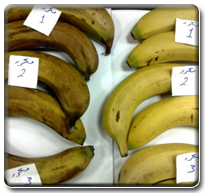 |
 |
 |
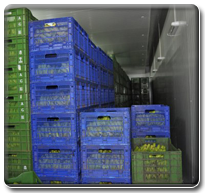 |
|
|
|
|
Symptoms
-
It is a physiological disorder that occurs in most fruits of tropical origin when subjected to temperatures below the critical temperature
-
Chilling injury can occur in either unripe or ripe fruit. It can cause lowering of market quality and value or total loss.
-
Surface lesions, such as pitting, large sunken areas and discolouration of the surface
-
Dark water soaked areas of the peel
-
Internal discolouration (browning) of pulp
-
Breakdown of tissues
-
Failure of fruits to ripen normally
-
Fruits harvest at mature but unripe stage develop a dull, grey skin colour, startch is no longer converted to sugar and fruits fail to ripen
-
When chilling is severe, fruits develops extensive sub-epidermal browning and eventually turn black
-
There is a loss of the development of the characteristic flavor, aroma and taste, and often the development of off-flavour
Management
-
Chilling injury can easily be avoided in Musa cultivars/hybrids by simply limiting storage or handling to temperature above the threshold.
-
Avoid refrigeration at below 13°c (55°F)
Choke throat
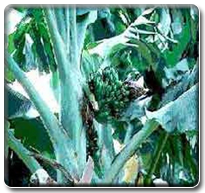 |
 |
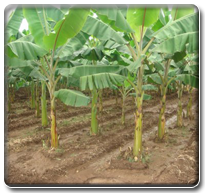 |
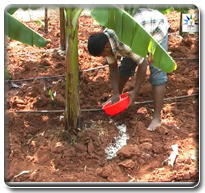 |
|
|
|
|
Symptoms
-
Choke throat occurs when the bunch is about to emerge from the top of the pseuodstem but becomes trapped at various stages of emergence.
-
In its most severe form the bunch fails to emerge from the top of the pseudo stem and instead bursts through the side of the pseudo stem. Such bunches are worthless.
-
In severe cases the top 1 or 2 hands become trapped in the throat of the plant leading to badly misshapen fruit.
-
Bunches which experience difficulty in emergence usually have several leaves closely ‘bunched’ together at the top of the pseudo stem
-
Choke throat is seasonal in nature. It is usually in the winter and early spring following cold weather. It can also occur in water logging or sever water stress conditions and following wind storms
Management
-
Select taller varieties, which are less susceptible to choke, throat, eg Williams.
-
Choose a warm environment, one which is well protected from frosts and strong winds. Slopes facing the north and north west are usually warmer.
-
Control time of bunching to avoid cold weather prior to bunching. Plants bunching in the late spring to mid autumn are less affected.
-
Good on-farm drainage measures including mounding of rows.
-
Regular irrigation to avoid water stress particularly during hot-dry weather.
-
Higher nitrogen rates are thought to be beneficial.
Goose flesh
Symptoms
-
Goose flesh is a physiological disorder which affects the banana peel.
-
The symptoms of this disorder have been observed on ripe fruits and the degree of peel damage varies from slight to severe.
-
Affected fruit has a wilted and shriveled appearance and the peel usually turns brown, when the fruit is handled.
-
The limited handling possibilities and unattractive appearance render 'goose flesh' fruits unpopular.
-
This disorder develops in fruits which develop in dry winter conditions or ripen under dry conditions ie, low humidity causes this disorder
Management
-
There is no remedial measure to overcome this disorder.
Hard lump
Symptoms
-
Rasthali is a very delicious and dessert variety. The disorder of hard mass or lump commonly occurs in this variety.
-
Lump are pinkish brown in colour, less luscious and firmer than the usually soft pulp and tastes like immature or unripe fruits, resulting in impaired eating quality of the fruit.
-
Lump development is related to lower day temperature during fruit development period and is generally seen in fruits harvested during July-December.
Management
-
This disorder can be overcome by adjusting planting time so as to harvest bunches during January-June.
-
by treating cut end of the harvested bunch or hand with 2,4-D at 500 to 1000 ppm.(0.5g in 1g in 1 litre water)
Neer vazhai
Symptoms
-
This disorder has recently been noticed in the `Nendran' banana grown in Tiruchirapalli district of Tamil Nadu.
-
Very low percentage of plants is affected and suckers from affected clumps carry the disorder.
-
It is characterized by fruitless bunches and cannot be detected until bunch emergence ie. no other symptoms appear.
-
The bunches have 4-5 hands and have only neutral flowers, the remaining nodal clusters consist of only persistent male flowers.
-
The malady may be due to imbalance of hormone or hormones influencing female flower development.
Management
-
No remedial measure
Abrasion Injury
 |
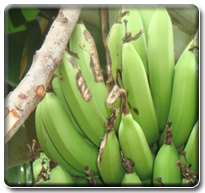 |
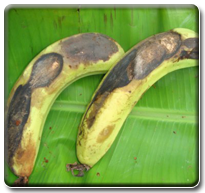 |
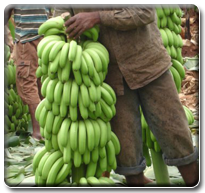 |
|
|
|
|
Symptoms
-
Abrasions result from skin scuffing against other fruits or surfaces of handling equipment or shipping boxes.
-
When exposed to low (<90%) relative humidity conditions, water loss from scuffed areas is accelerated and their colour turns brown to black.
Management
-
Careful handling to minimize the abrasion injury
-
Avoid the fruits under refrigeration below 90% relative humidity
November dump
Symptoms
-
Cold temperatures also have a marked effect on bunch development. When the flower initiation occurs during the winter, a characteristically a peculiar bunch can be expected.
-
The November dump bunch is small and composed of hands of uneven size and often deformed fruits. The smaller fingers on the hands are, in many cases, fuller at the flower end and thinner at the stalk end.
-
The flower end is often black, rough and cracked and during a good rainy season, fungal diseases further damage these fruits.
-
Another common symptom is the cone-shaped protuberance at the flower end. This protuberance is pale green in colour. The amount of misshapen fruit as November-emerging bunches varies from year to year.
-
It must be stressed that November dump symptoms are caused by cold temperatures and they are not mineral deficiency or drought symptoms.
Management
-
A good orchard practice is to cut down all the plants producing severe November dumps.
